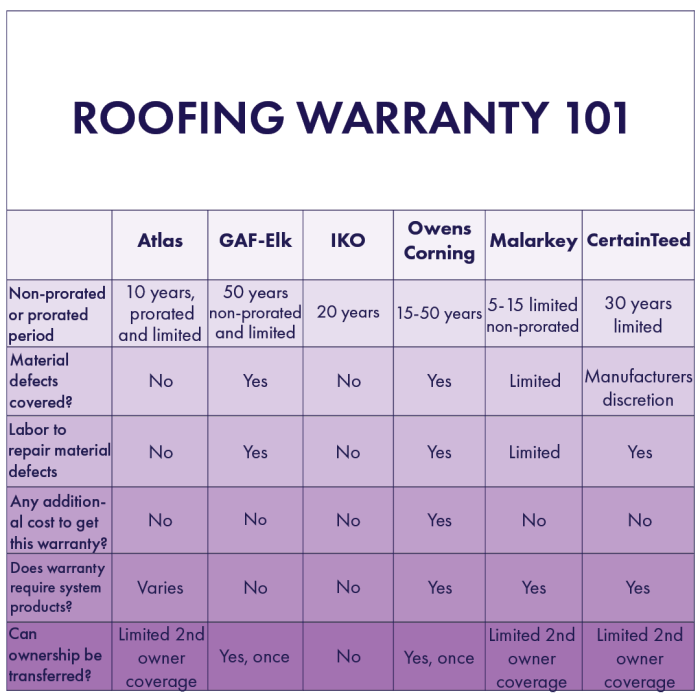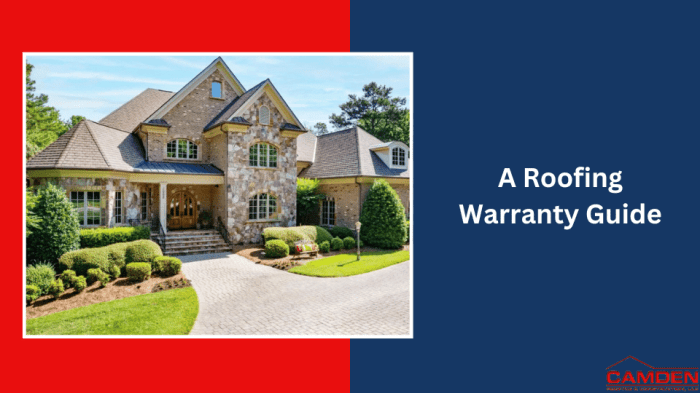Exploring Roofing Warranty Options: A Comprehensive Guide

Delving into the realm of roofing warranty options, this introductory paragraph aims to provide a captivating overview of the various choices available to homeowners and the factors to consider when selecting the best option for their needs.
As we navigate through the intricacies of roofing warranties, we will uncover key insights and practical tips to help you make informed decisions regarding your roof's protection and longevity.
Table of Contents
ToggleTypes of Roofing Warranty Options
When it comes to roofing warranty options, there are several choices available in the market to provide homeowners with peace of mind and protection for their investment. Let's explore the different types of roofing warranties and their key features.
Manufacturer Warranties vs. Contractor Warranties
Manufacturer warranties are typically provided by the companies that produce the roofing materials themselves. These warranties often cover defects in materials and workmanship for a certain period, which can range from 20 to 50 years depending on the type of material.
On the other hand, contractor warranties are offered by the installation company and cover the labor and installation of the roof. These warranties usually have a shorter duration compared to manufacturer warranties, averaging around 1 to 10 years.
Extended Warranties and Benefits
Extended warranties are additional coverage options that homeowners can purchase to further protect their roofs beyond the standard warranties. These warranties can extend the coverage period, provide additional protection against specific damages like leaks or wind damage, and may include maintenance services.
While extended warranties come at an extra cost, they offer peace of mind and ensure comprehensive protection for your roof investment.
Factors to Consider When Choosing a Roofing Warranty

When selecting a roofing warranty, it is crucial to carefully consider various factors to ensure you make the right choice for your needs. Factors such as coverage, duration, transferability, and the type of warranty can greatly impact the protection and value you receive.
Prorated vs. Non-Prorated Warranties
When comparing roofing warranties, one key difference to be aware of is whether they are prorated or non-prorated. Prorated warranties decrease in value over time, meaning you may receive less coverage as the years go by. On the other hand, non-prorated warranties offer consistent coverage throughout the warranty period, providing more reliable protection.
Impact of Climate and Roofing Materials
The climate in which your home is located plays a significant role in determining the effectiveness of your roofing warranty. Harsh weather conditions can accelerate wear and tear on your roof, making it essential to choose a warranty that can withstand such challenges.
Additionally, the type of roofing materials used can also affect warranty options, as some materials may require specific warranty coverage to ensure durability and longevity.
Understanding Warranty Coverage

Roofing warranties are crucial in protecting your investment and providing peace of mind. Understanding what typical roofing warranties cover, as well as the exclusions and common warranty claims, is essential for homeowners looking to ensure their roof's longevity and performance.
What Typical Roofing Warranties Cover
- Material defects: Most roofing warranties cover defects in materials, such as shingle granule loss, cracking, or premature deterioration.
- Workmanship: Warranty coverage often includes errors in installation or workmanship that result in leaks or other issues.
- Repairs: Some warranties may cover the cost of repairs for certain issues that arise during the warranty period.
Exclusions in Roofing Warranties
- Natural disasters: Damage caused by natural disasters like hurricanes, earthquakes, or floods is typically not covered under roofing warranties.
- Lack of maintenance: Failure to properly maintain the roof, such as regular inspections and repairs, can void warranty coverage.
- Unauthorized repairs: Making repairs or modifications to the roof without manufacturer approval can also nullify warranty protection.
Common Warranty Claims and Handling
- Leak repairs: One of the most common warranty claims is for leaks, which are typically addressed by the manufacturer sending a certified contractor to assess and repair the issue.
- Material defects: If a homeowner notices defects in the roofing materials, they can file a claim with the manufacturer to have the faulty materials replaced or repaired.
- Workmanship issues: Warranty claims related to poor workmanship are typically resolved by the manufacturer sending an inspector to assess the problem and determine the appropriate course of action.
Making the Most of Your Roofing Warranty
When it comes to maximizing the benefits of your roofing warranty, there are a few key steps you can take to ensure you are fully covered and prepared for any potential issues that may arise.
Designing a Maintenance Plan
One of the best ways to make the most of your roofing warranty is to design and implement a regular maintenance plan for your roof. By staying on top of routine inspections and repairs, you can help prevent small issues from turning into larger problems that may not be covered by your warranty.
Registering Your Warranty and Keeping Documentation
It is crucial to register your roofing warranty with the manufacturer or contractor as soon as your roof is installed. Be sure to keep all necessary documentation, including the warranty certificate, receipts, and any maintenance records. This will make it easier to file a claim if needed and ensure that you are in compliance with the warranty requirements.
Properly Inspecting Your Roof
To identify any issues covered by your warranty, it is essential to conduct regular inspections of your roof. Look for signs of damage such as missing shingles, leaks, or sagging areas. If you notice any problems, be sure to address them promptly and document the repairs for future reference.
Summary
In conclusion, understanding the nuances of roofing warranty options is essential in safeguarding your investment and ensuring peace of mind for years to come. By applying the knowledge gained from this discussion, you can confidently navigate the world of roofing warranties and make the most out of your roof's protection.
FAQs
What are prorated warranties?
Prorated warranties decrease in coverage over time, meaning the longer you have the roof, the less the warranty covers. Non-prorated warranties maintain the same coverage throughout the warranty period.
How does climate affect warranty options?
Extreme weather conditions can impact the lifespan of your roof and may influence the type of warranty you choose. Areas prone to hail or high winds may require more comprehensive coverage.
What are common exclusions in roofing warranties?
Natural disasters like earthquakes or hurricanes, as well as lack of proper maintenance, are often excluded from roofing warranties. It's important to understand these exclusions before selecting a warranty.
How should I inspect my roof for warranty-related issues?
Regular inspections, especially after severe weather events, can help identify potential issues covered by your warranty. Look for signs of damage or wear and tear that may require attention.
Related posts
Mastering Apartment Property Management: A Comprehensive Guide
Featured Posts
- How to Sell My House Fast: A Comprehensive Guide
- The Ultimate Guide to Pergola Installation Services
- The Best Security Doors for Homes: A Comprehensive Guide
- Driveway Gate Cost Estimator: Factors, Types, Materials, Installation, Maintenance
- Mastering Apartment Property Management: A Comprehensive Guide
Tags
bathroom (2) best buy (1) bid platforms (1) construction bid sites (1) Cozy Living (1) design trends (2) Energy Efficiency (2) Exterior Design (2) Furniture (2) Home Decor (8) home improvement (7) home security (3) Installation (2) Interior Decor (3) Interior Design (12) maintenance (3) options (1) outdoor living (2) professional contractors (1) project bidding (1) property market (2) real estate (3) Renovation (3) residential painting (2) roofing (1) siding materials (2) smart thermostat (1) technology (3) Tenant Satisfaction (1) warranty (1)
Categories
- Business (1)
- Construction (1)
- Design (7)
- General (50)
- Home & Garden (2)
- Home & Living (1)
- Home Decor (2)
- Home Improvement (21)
- Home Security (3)
- Interior Design (6)
- Property Management (1)
- Real Estate (4)
- Real Estate Industry (1)

